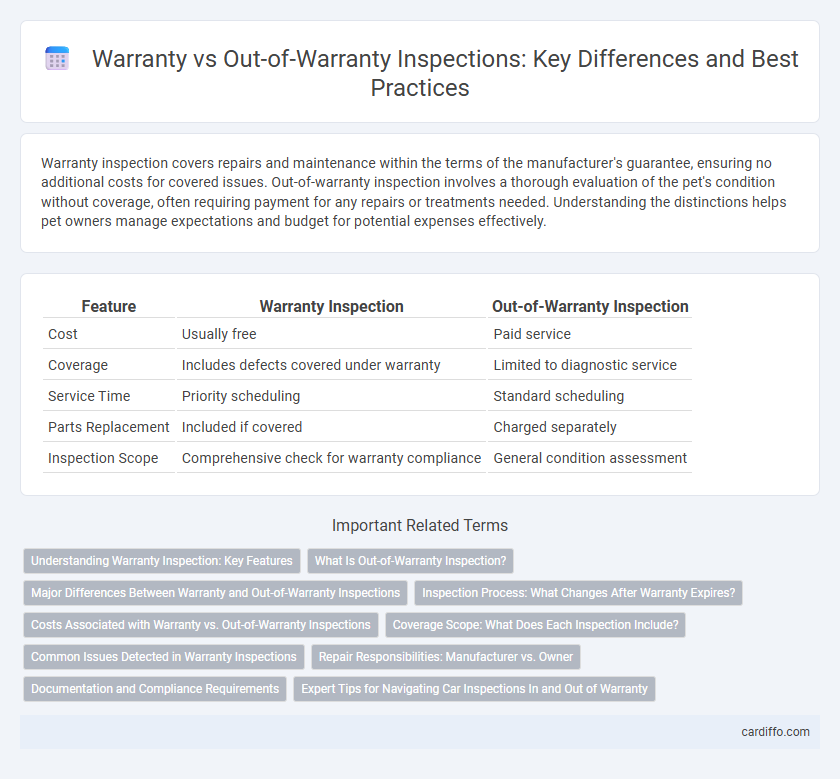Warranty inspection covers repairs and maintenance within the terms of the manufacturer's guarantee, ensuring no additional costs for covered issues. Out-of-warranty inspection involves a thorough evaluation of the pet's condition without coverage, often requiring payment for any repairs or treatments needed. Understanding the distinctions helps pet owners manage expectations and budget for potential expenses effectively.
Table of Comparison
| Feature | Warranty Inspection | Out-of-Warranty Inspection |
|---|---|---|
| Cost | Usually free | Paid service |
| Coverage | Includes defects covered under warranty | Limited to diagnostic service |
| Service Time | Priority scheduling | Standard scheduling |
| Parts Replacement | Included if covered | Charged separately |
| Inspection Scope | Comprehensive check for warranty compliance | General condition assessment |
Understanding Warranty Inspection: Key Features
Warranty inspection involves a thorough evaluation conducted within the predefined warranty period, ensuring that identified defects and malfunctions are eligible for repair or replacement at no cost to the customer. It typically includes detailed diagnostics, verification of warranty terms, and documentation of findings to facilitate claims processing. Out-of-warranty inspections differ by focusing on defect assessment without coverage guarantees, often resulting in repair cost estimates prior to authorization.
What Is Out-of-Warranty Inspection?
Out-of-warranty inspection refers to the evaluation of a product or equipment performed after the manufacturer's warranty period has expired, often focusing on identifying issues that are no longer covered for free repair or replacement. This type of inspection typically assesses wear and tear, potential defects, and maintenance needs to determine repair costs and extend the service life of the item. Unlike warranty inspections, out-of-warranty inspections emphasize cost estimation and risk assessment for owners responsible for all repair expenses.
Major Differences Between Warranty and Out-of-Warranty Inspections
Warranty inspections cover repairs and services within the manufacturer's specified period, ensuring no additional cost for covered parts and labor. Out-of-warranty inspections involve charges for diagnostics, parts, and labor since the product's warranty period has expired. The major difference lies in financial responsibility, coverage scope, and eligibility for complimentary service under warranty terms.
Inspection Process: What Changes After Warranty Expires?
Warranty inspection typically involves a manufacturer-approved process that includes free or low-cost evaluations focused on defects covered by the warranty terms, using authorized service centers and specific diagnostic protocols. After the warranty expires, out-of-warranty inspection shifts to a customer-funded model, often requiring broader diagnostics to assess wear-and-tear or unrelated issues, with potential use of third-party service providers and more detailed cost estimates. The inspection process post-warranty prioritizes comprehensive assessment and transparent reporting, as repair decisions become more financially driven without automatic manufacturer coverage.
Costs Associated with Warranty vs. Out-of-Warranty Inspections
Warranty inspections typically incur minimal or no direct costs to the customer as they are covered by the manufacturer or service provider. Out-of-warranty inspections often involve higher expenses, including diagnostic fees, replacement parts, and labor charges not covered by any warranty agreement. Understanding the distinction between warranty and out-of-warranty inspection costs is crucial for budgeting and anticipating potential financial responsibilities during equipment or vehicle maintenance.
Coverage Scope: What Does Each Inspection Include?
Warranty inspections cover defects and malfunctions explicitly stated in the product's warranty terms, including parts, labor, and repairs necessary to restore functionality. Out-of-warranty inspections evaluate the overall condition of the product, identifying wear, damage, and potential issues not covered by warranty, with costs typically borne by the owner. Coverage scope in warranty inspections guarantees repairs or replacements for covered faults, while out-of-warranty inspections provide diagnostic assessments and maintenance recommendations without guaranteed repairs.
Common Issues Detected in Warranty Inspections
Warranty inspections commonly detect manufacturing defects, faulty components, and installation errors covered under the product's warranty terms. These inspections focus on verifying compliance with warranty conditions and identifying issues eligible for free repair or replacement. In contrast, out-of-warranty inspections typically reveal wear and tear, user damage, and maintenance-related problems not covered by the warranty.
Repair Responsibilities: Manufacturer vs. Owner
Warranty inspections typically place repair responsibilities on the manufacturer, who must address defects or malfunctions covered under the warranty terms. Out-of-warranty inspections shift the repair burden to the owner, requiring them to cover diagnostic and repair costs unless additional service agreements exist. Understanding these distinctions is crucial for determining financial obligations and service expectations during equipment assessments.
Documentation and Compliance Requirements
Warranty inspections require thorough documentation including proof of purchase and compliance with manufacturer guidelines to validate coverage eligibility. Out-of-warranty inspections often demand detailed records of previous maintenance and repair history to assess current condition accurately. Both inspections must adhere to industry standards and regulatory compliance to ensure legitimacy and traceability.
Expert Tips for Navigating Car Inspections In and Out of Warranty
Warranty inspections typically cover repairs and diagnostics outlined by the manufacturer, ensuring costs are minimized for covered parts and services. Out-of-warranty inspections require careful attention to potential repair expenses and may involve thorough evaluations that uncover issues not addressed under warranty. Expert tips recommend maintaining detailed service records and proactively identifying wear and tear to negotiate better service terms during out-of-warranty inspections.
Warranty inspection vs out-of-warranty inspection Infographic

 cardiffo.com
cardiffo.com